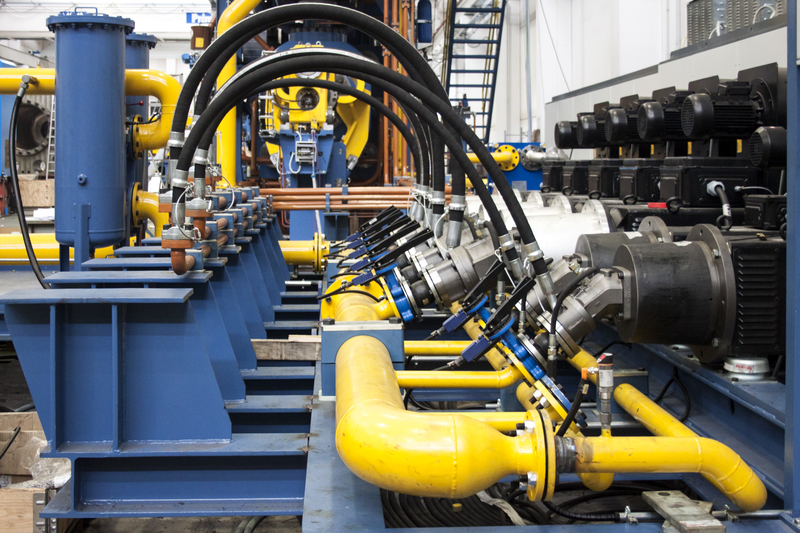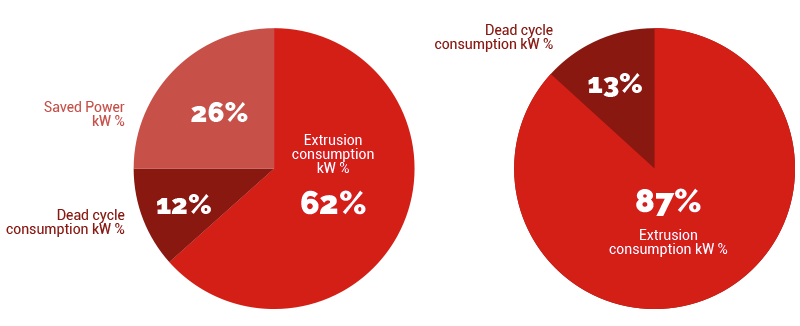PRESEZZI EXTRUSION - A PIONEER IN ENERGY SAVINGS
20-09-2018
A scrupulous and skilled designer and constructor of non-ferrous extrusion plants must never forget two fundamental elements necessary to manufacture a product of excellence: productivity and efficiency. Productivity ensures the quality and dimensional characteristics of the finished product, which conforms to the specifications of the customer, and efficiency ensures production standards over time and a reduced consumption of resources in order to achieve the objectives.
But how to obtain the steady improvements in productivity and efficiency to create a product in line with modern market requirements?
It is only possible if you invest time and resources in research and development, pool know-how without giving up experimenting and incorporate new technological features in plant and machinery, and last but not least ensuring fast and competent after-sales support for the customer. For these reasons Presezzi Extrusion, right from the start, has invested constantly in R&D activities and in a constant and attentive monitoring as well as improving its after-sales service.
R&D aims to ensure the evolution of the machines and production lines in terms of further improved productivity and quality, short and long-term reduction of energy costs as well as time and costs for maintenance and after-sales services. For Presezzi, investing in R&D has always been of high priority, involving the best internal resources and qualified research institutes, and always in regard to energy savings, ERP L1 programmes for total plant and production management, excellent quality of the extruded product and a reduction of the production costs.
The PE Energy Saving System
2007 was a turning year for Presezzi Extrusion as the company started to develop a new type of hydraulic system for their presses. All presses designed and built until 2007 had (without exception) pumps with variable flow rates paired with servovalves and standard type electrical motors.
In 2009, after 18 months of intense R&D to meet customers' demand for significant energy savings in the production process while maintaining and/or improving production performance and the quality of the extrusions, Presezzi developed a solution termed the PE Energy Saving System (PE. E.S.S.). This system is based on two pillars: savings and technological innovation. The savings concept does not only include energy saving, but also the machines through a smaller number of components required for their operation, making the manufacture and installation of the press leaner and less subject to production stops and downtimes for maintenance.
Thanks to a close collaboration with a leading Italian extrusion company active in the field of hard alloys, the first prototype unit was built. It confirmed the initial intuition and successful technological development and proved a significant energy saving value through field tests.
The first press equipped with this innovative energy saving system was a 33-MN front loading press in 2009. Since then most Presezzi presses have been equipped with the PE. E.S.S. This refers to more than 80 presses which enjoy high esteem by the customers.
In comparison to an extrusion press fitted with a conventional up-to-date hydraulic system - what exactly reduces the energy consumption of a PE. E.S.S. press by 26% (on average, depending on different types of product)?
In conventional systems all pumps are continuously operating with traditional drive systems; they consume energy even if it is not needed which is a pure waste of money. The PE. E.S.S., however, only uses the amount of energy that is really required; the energy consumption is significantly reduced by putting the hydraulic pumps in stand-by mode when the press is not operating or does not require a specific cycle of the extrusion process.

To understand the advantages of the PE. E.S.S. means to understand what is actually taking place during the extrusion process.
The hydraulic system in a traditional press is usually dimensioned to reduce dead times and normally uses only 20 to 30% of its capacity for the extrusion process. During the extrusion phase of a traditional press, the quantity of oil required to obtain a regular and constant speed is distributed by the hydraulic pumps using a system which regulates the flow rate in the pumps, managed by the servovalves. This means that apart from the energy consumption brought about by the pumps dedicated to commanding the servovalves, in conditions where the main pumps are underused they carry on turning, thereby wasting energy and continuing to heat up the oil.
The PE.E.S.S. system allows the press to generate exactly the right quantity of oil that is really required by the system to obtain the force and speed necessary for the extrusion process. The low inertia motors are controlled by inverters and by the fixed displacement pumps connected with them and the volume of oil distributed is exactly the amount required for all press movements for each and every operation.
The advantages these types of low inertia motors offer are considerable and this system allows much higher performance values than that of a conventional system with servovalves and pumps with variable flow rates.
According to the requirements, the pumps are turned on and off automatically and their rpm speeds are adjusted accordingly. Those pumps which are not required during the extrusion phase remain completely idle. There are no dedicated or auxiliary pumps that distribute the oil to various other functions or the need to pump excess oil out of the system.
Further savings are gained during press stoppages or die changes.
The energy savings compared to those on a traditional press can be calculated at around 25 to 30%, depending on the type of product to be extruded and the type of cycles to be executed.
The PE.E.S.S. can also be installed on existing presses. In recent years, Presezzi has successfully carried out numerous revamps. After analysing the type of press and its characteristics, the old hydraulic unit is replaced with the PE.E.S.S. system, with all the necessary modifications and replacement of parts like piping, the electrical system, electronics and software.
The advantages which can be achieved by using this system are, in brief:
- Reduction of the power required and the dimensions of the motors
- Less oil required
- Less expensive pumps can be used which make the system more economic to run, with lower spare parts turnover and significantly reduced maintenance requirements
- The installation in the pump room requires less space and generates less noise during operation
Summary
Since 2007 Presezzi Extrusion has developed constructed and successfully installed a system which is characterized by a new design, philosophy and the use of low inertia electrical motors. Before 2007, no one used these, kinds of motors for this application. It's fai to say that Presezzi Extrusion is a frontrunner in energy savings and technological innovation.
 The innovative technological feature, which have been developed allow the company to maintain a leading position in the market. This is acknowledged by the customers through the development of solutions that are state of the art and meet the ever rising demand for increased productivity in the aluminium, brass and copper alloys sectors.
The innovative technological feature, which have been developed allow the company to maintain a leading position in the market. This is acknowledged by the customers through the development of solutions that are state of the art and meet the ever rising demand for increased productivity in the aluminium, brass and copper alloys sectors.